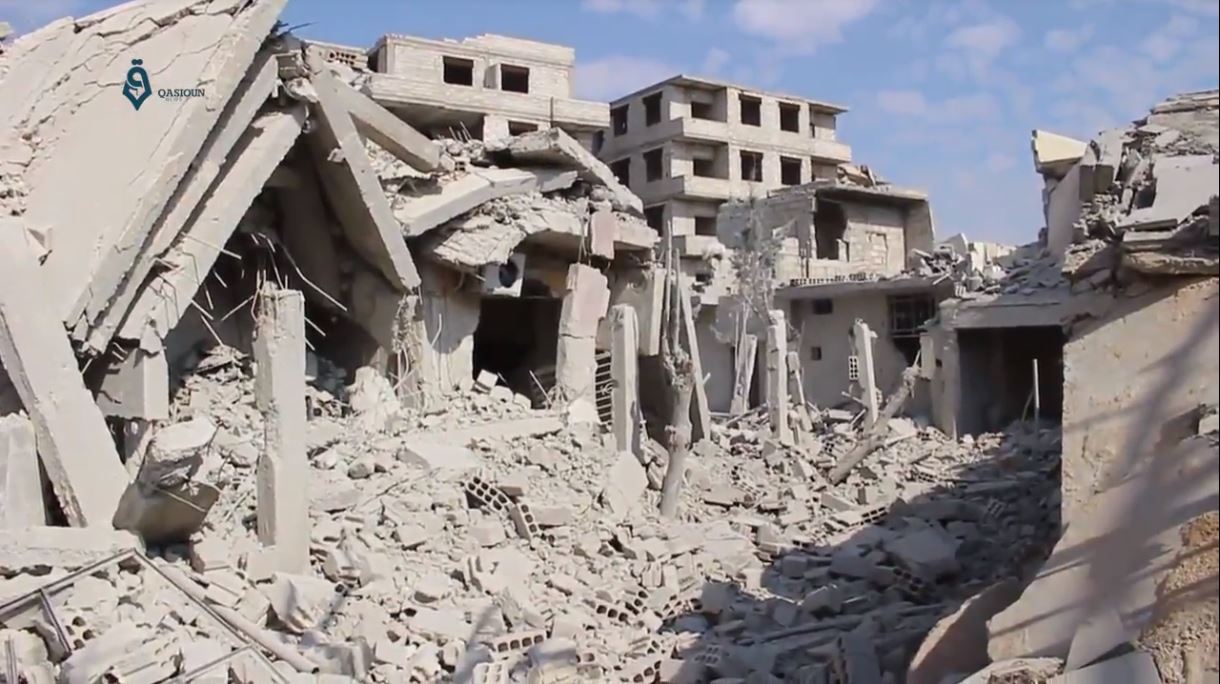The civil war in Syria started in March 2011 and continues over seven years later. The conflict involves not only the Syrian regime of Bashar al-Assad, but also Syrian opposition fighters, Turkey, Kurdish elements, Iran and its proxy Hezbollah, Israel, Russia, the United States, remnants of the so-called Islamic State, and other countries that are harboring refugees from the fighting. In a recent public event, Brookings experts examined the facets of the ongoing conflict and offered ideas for the way ahead. Below are highlights from the event. Full event audio, video, and a transcript are available here.
Michael O’Hanlon, senior fellow in the Center for 21st Century Security and Intelligence and director of research for Foreign Policy, moderated the panel and explained the current situation in Syria. He noted that seven years of fighting have left over half a million dead, and 12 million—nearly half the pre-war population—displaced from their homes, with 5 million refugees in nearby countries and in Europe. Syrian President Assad controls about one-third of the territory, with 75 percent of the populated areas. Kurds control 20 percent of territory in the north, with a few million inhabitants. He called attention to other pockets of conflict, including Eastern Ghouta near Syria’s capital Damascus; Afrin in the north where Turkey is fighting Kurds; around Idlib where opposition groups continue to operate; and near the Israeli border in the southwest of the country [for more, see Institute for the Study of War situation map].
“What this adds up to,” O’Hanlon concluded, is that:
President Trump’s national security team seems to assess that Assad is bent on retaking the whole country. Yet at the same time, we’ve heard General Votel of Central Command and others make this assessment: they also underscore, Assad doesn’t really have the forces to hold the whole country and he certainly doesn’t have the forces to take everything back at once. So, the question then becomes how much of the country can we help our local allies hold on to and create some local autonomous areas of self-governance in the meantime, along the way, as we still envision a long-term goal of seeing Assad replaced?
“I have very serious doubts as to whether the replacement of Assad can be a realistic U.S. policy goal,” O’Hanlon added, “but we still cling to that hope through the Geneva negotiation process and through various kinds of public statements, for example, by Secretary of State Tillerson in his speech at Stanford on Syria in January.” O’Hanlon later said about the Geneva process: “I think the Geneva process is counterproductive, not just a long shot, but counterproductive because it deludes us into thinking we have a political strategy when we don’t.” He continued:
And I would rather see it simply terminated or fundamentally redefined along the following lines: let’s acknowledge there is not going to be a negotiated transition of power in Syria in the short-term, period. There isn’t because for Assad, that is snatching defeat from the jaws of battlefield victory. It’s just that simple for him. He watched what happened in Iraq. This is the mirror image.
TURKEY, THE KURDS, AND TENSION WITH THE UNITED STATES
Amanda Sloat, Robert Bosch Senior Fellow in the Center on the United States and Europe at Brookings, addressed the Turkey and Syrian Kurd pieces of the conflict. She noted that when the uprising started, Turkish President Erdoğan “initially engaged with Assad to see if there was a way that he could encourage him to make some democratic reforms that would bring the conflict to a quick and a peaceful resolution without becoming more of a military conflict.” But when “Assad did not listen” and the civil war began, the Turkish leader “turned on Assad.” Because Erdogan’s “primary objective in Syria became the quick overthrow of Assad,” Sloat said Turkey allowed some foreign fighters to cross its border with Syria.
Sloat said President Obama did not want to involve the United States in the civil war, but the U.S. did take military action to counter the Islamic State. In seeking ground forces with whom to partner, American Special Forces began working with a faction of Syrian Kurds (the YPG). Turkey objected to this partnership given the YPG’s ties to the PKK—a designated terrorist organization that has long battled the Turkish state.
Sloat explained, “Turkey’s overarching objective right now is to prevent the formation of an autonomous [Kurdish] region” in Syria along the Turkish border, which it views as a security threat. In order to block the YPG from achieving this political objective, Erdoğan has launched military operations in Afrin in northwestern Syria. Because Russia controls the airspace there, Turkey has needed its blessing. “So it’s really creating tension between the United States and Turkey in terms of going forward in Syria and also creating interesting dynamics between Turkey and Russia.”
IRAN AND HEZBOLLAH: A POWERFUL EXPEDITIONARY FORCE
Suzanne Maloney, senior fellow in the Center for Middle East Policy and deputy director of the Foreign Policy program, explained that the Syrian civil war is part of a broader set of wars in the region, that it is “morphing into one or more regional conflicts, involving the regional players as the main actors in this conflict.” She continued:
I think that shift from the first horrific phase of the Syrian civil war to what could be a conflict involving both the United States, Russia, as well as the regional superpowers is going to be one which could even become more horrific.
And that is why I think we wanted to come together today, not simply to talk about the track record and what we’ve seen over the course of the past seven years, but to sound a warning for the future and for the need for a coherent American policy to address the conflict in Syria, not simply because of the refugees, which has been a subject of a lot of work of our colleagues around Brookings; not simply because of the humanitarian implications or the strategic implications in the conflict as it’s gone to date, but what may come is really dangerous. We’re entering this new phase; it was entirely predictable. We don’t know where it’s going from here.
“The involvement of the Iranians,” Maloney said, “is long-standing and multifaceted.”
RUSSIA: NO VITAL INTERESTS IN SYRIA
Pavel Baev, nonresident senior fellow with the Center on the United States and Europe and a research professor at the Peace Research Institute Oslo, offered his analysis of Russia’s intervention in Syria, characterizing it as “a very high-risk and also a low-capacity enterprise.“ It has been, Baev said, “a remarkably successful exercise in projecting power, successful to such a degree that last autumn, after the meeting with these two partners [Erdoğan and Iranian President Hassan Rouhani] in Sochi, Putin proclaimed victory. And that was exactly the point where everything went wrong,” referring to recent confusion and a U.S. military strike on Russian mercenaries.
Baev looked ahead:
WHAT’S NEXT FOR U.S. POLICY IN SYRIA?
After explaining the context of the civil war in Syria, the panelists looked ahead in a discussion of U.S. policy toward Syria and the region. Sloat, who served in the Obama administration in various roles related to Middle East issues, declared that “I am not clear what current U.S. administration policy is on Syria.” She noted conflicting messages from senior administration officials, citing former Secretary of State Tillerson’s approach laid out in his Stanford speech in January, President Trump’s recently expressed views on leaving Syria, and U.S. Special Forces’ stated commitment to continuing its alliance with Kurdish YPG forces on the ground.
“I think there is a lot of confusion within the administration about what ultimate objectives are,” Sloat said. She expressed concern about a divided post-ISIS Syria that could trigger renewed conflict:
Whatever configuration you end up having is that you have a situation where you have the Kurds controlling territory on the north. You have Assad and the Alawites continuing to control a lot of the wealthier coastal land on the western side of the country. And then you have a big area of desert with lots of disenfranchised, angry Sunni populations, which is a good recipe for ISIS 2.0. And so then there’s a real risk that in a couple of years we end up replaying this game all over again.
Maloney addressed the Trump administration’s policy on Syria in the context of applying pressure on Iran to diminish its control of Syrian politics and transform its regional policies.
“[T]he kind of fixation on the nuclear deal and what, I think, now is an almost inevitability that the United States will abrogate its participation in that deal and get absolutely nothing in return from the rest of the world or from the Iranians, has sacrificed an incredible opportunity,” Maloney said.
Baev, too, noted that Russia would likely support a more hardline U.S. stance on Iran in Syria and the region. As he explained:
Other than that, Russia really wants to be taken on board, to be taken seriously, to be engaged in some form or shape, and … through that engagement it is probably possible to make Russia agree to just about anything the United States would want to accomplish short of removal of the al-Assad regime, which is still somewhat of an important proposition.
Russia would agree, Baev said, to a replacement of Assad through a political process, but not through revolution.
O’Hanlon addressed the serious issue of rebuilding Syria—so badly damaged after seven years of civil war, with an estimated reconstruction cost of around a hundred billion dollars—as well as Assad’s future. “[M]y bottom line,” O’Hanlon said, “is that the only thing we can hope for with Assad is that he allow autonomous governance in some of these more remote areas and we should work hard on a full-bore reconstruction effort there and even try to persuade the World Bank and other foreign donors to work with these subnational entities as they emerge.”
WHAT HAPPENS IN SYRIA DOESN’T STAY IN SYRIA
Maloney offered a succinct coda to the discussion of Syria’s civil war and what happens next. It’s not just about Syria, but about the region and potential terrorist activity that threatens people and nations everywhere.
“I understand the temptation to turn our backs on this very messy part of the world, but I think that inevitably we have an interest and a real stake in creating a better future,” Maloney said.
Full event audio, video, and a transcript are available here. See a roundup of other analysis and commentary from Brookings experts on Syria.

